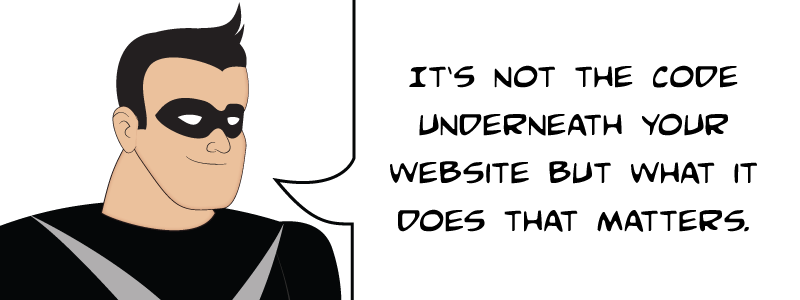Are you focusing more on client-side development or server-side development? Do you even know the difference? Simply put, your website uses HTML and CSS to display content. If you require a bit more from your website you probably will also need some Javascript and maybe some PHP and ASP.NET. If all of these acronyms have your head spinning don’t worry. This article will make things perfectly clear.
Client-Side Languages
Javascript is the typical go-to programming language for client-side development. Developers use Javascript to add functionality to your web pages by adding code that runs on our computer after you’ve loaded a web page. Your browser loads the web page and executes the Javascript on your computer. This is why it’s called “client-side”. Take a look at this example:
<script>
document.getElementById("message").innerHTML = "Hi there!";
</script>This example shows Javascript locating an element on the page with the id of “message” and changing its content to “Hi there.”. This could be an error message or status update for the visitor to see after an interaction. What was originally inside that element gets replaced. When a visitor clicks a button or fills out a form this is called User Interaction. Most user interactions will be handled by Javascript. Button clicks and hovering over elements are all things a visitor does after the page loads. So it makes sense that Javascript would handle those types of things too. Javascript has another powerful ability. It can reach out to other data sources and get more content! This means you can program a button to dynamically do a Google search and return the results. Developers can use that data to update the content on the page for the visitor to see. This process is known as Asynchronous JavaScript And XML or AJAX. AJAX is a set of Web development techniques using many Web technologies on the client-side to create asynchronous Web applications. That was a mouthful!
Server-Side Languages
There is a wide range of server-side languages, but the most popular are PHP and ASP.NET. Javascript can also be used as a server-side language using what’s commonly known as Node. The HTML code that is displayed in your browser is first processed on the server. Developers use server-side languages to retrieve data and manipulate the layout before the web page is displayed. Take a look at this example of PHP:
<div id='message'><?php echo 'Hi there!'; ?></div>
This code has the exact same effect as the Javascript example in the previous section. It puts the text “Hi there.” into the paragraph element. The difference is that PHP put the text inside of the element before the HTML was sent to the browser and displayed. If you were to view the source of the page you would see the text as if it was part of the original HTML code. Server-side code is run on the server and thus is not seen by web visitors. This provides some anonymity to the code which translates to better security. Javascript, however, is loaded onto the web page and is visible to those who know how to find it.
Conclusion
Most websites make use of both a client-side and a server-side language. While you can do things with both, there are certain tasks that only one can do. Client-side is good for anything that requires user interaction like clicking buttons. Server-side is good for anything that requires dynamic data to be loaded like search results. Ultimately, you must evaluate your needs and decide which way works best for your needs. It is not a one size fits all. If you need some assistance figuring it out you can always reach out to User X for help.
Here’s a link to schedule a 20-minute phone consult.

